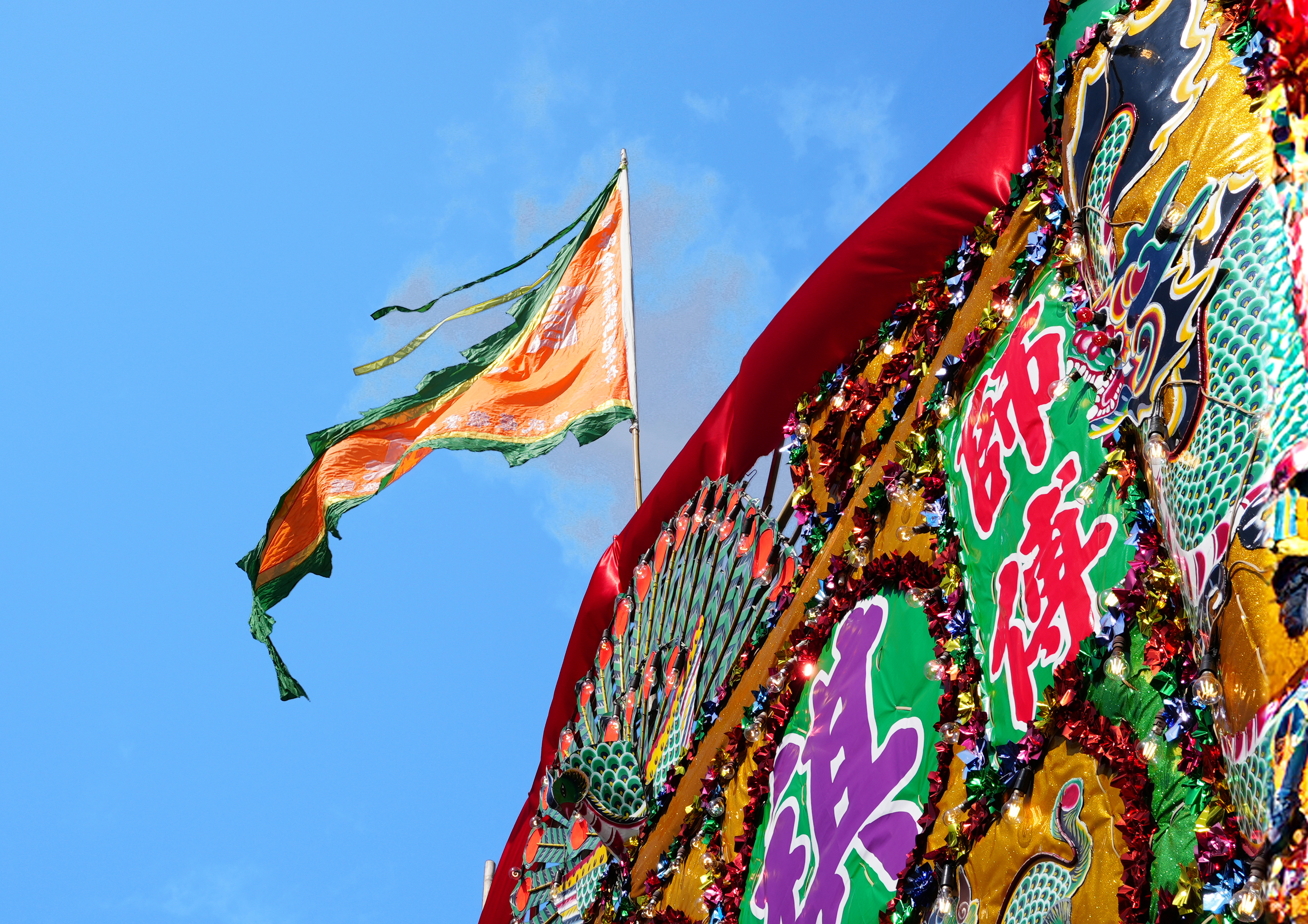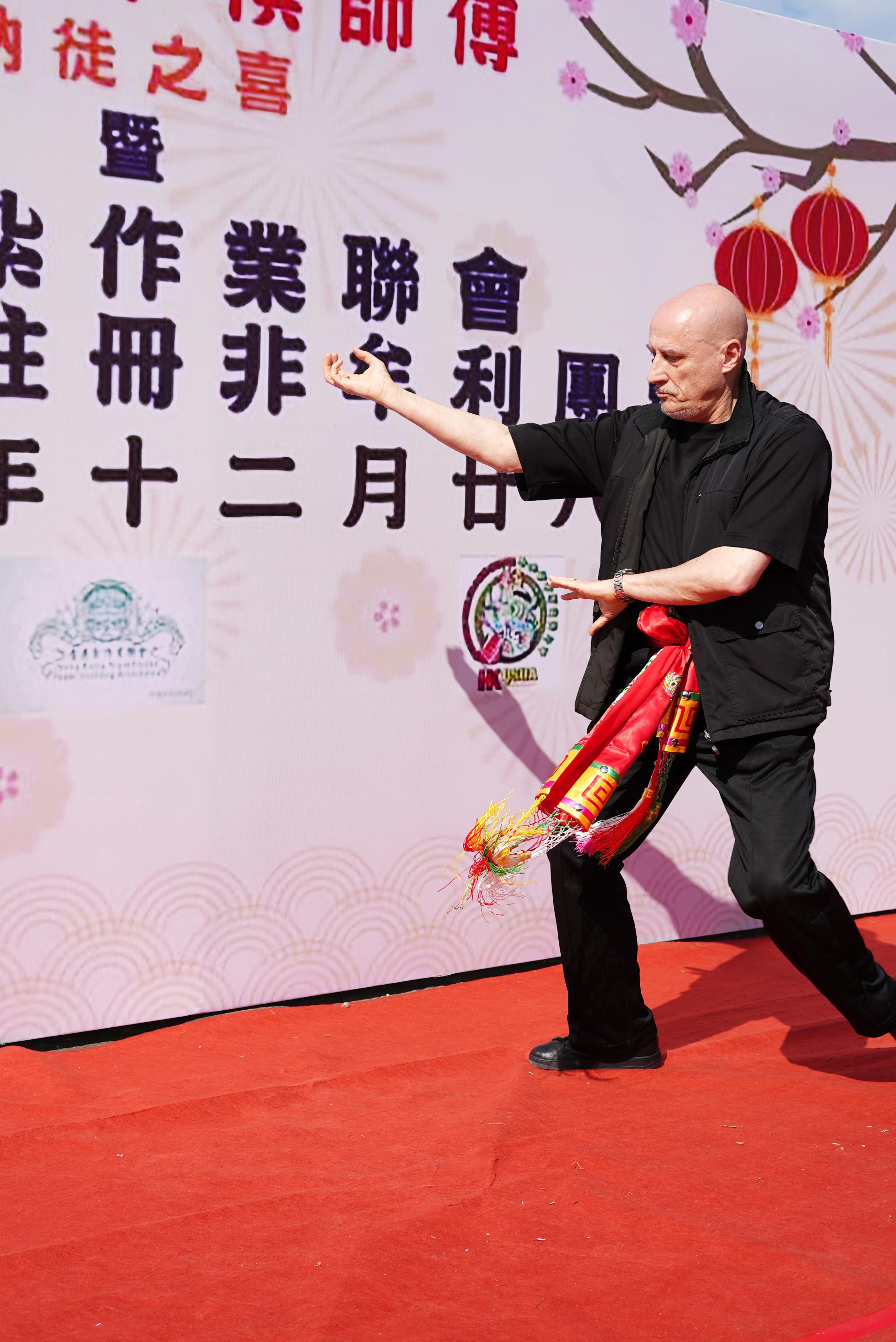Beyond Loss and Win: A Belgian Martial Artist’s Quest for Chinese Culture ![]()
![]()
Author: YANG Chen (Correspondent)
On a winter morning in Hong Kong, a Belgian martial artist, Mr. Ronald Galland, travelled thousand miles away to Hong Kong to learn traditional Chinese Pi Yao Dance from Mr. Kenneth Mo, the chairman of Hong Kong Traditional Paper Crafting Arts Union. Under the joint witness of the community, this martial artist expanded his Kung Fu experience from his martial arts school in Chinatown in Belgium to the new companions in Hong Kong, and created a bridge of friendship between Hong Kong and Belgium. It is these tiny but very important interpersonal relations that bring people closer, and frame and reshape time.
THE RITUAL
It was a cloudy day, but not dull. We drove to the Earth Temple located at Kwu Tung area in Sheung Shui, a place that was 39 kilometres far from the bustling centre of Hong Kong. The clear tranquil countryside along the way brought some covert but spirited excitement. It was not clear at that point to tell what it was.
We arrived at the exact time. The ritual was fully prepared and about to begin. Kenneth Mo strode to us with his passionate greetings, in his Chinese black gown as always. Ronald Galland was in black, surrounded by his wife and his seven apprentices. They were all in bright red, with three black characters with gold trim saying “Lok Kwai Ping” on it. The surroundings were hustling: guests, speakers, hostesses, photographers, friends and witnesses, all moving around under the giant colorful Flower Stand. People were waiting for the ceremony to begin.
Galland was very impressive in the crowd. His beard was all white and had a focused expression. His eyes were clear and bright. Mo approached him and confirmed several matters—the two main characters for today were ready.

“It’s time for the ritual to start. Mr. Galland and his apprentices, please follow Master Mo’s lead to make an offering to the sky and the earth.” The hostess announced.
Next second, the music suddenly started. Gongs, drums, and cymbals babbled and jingled. The man in front raised a crafted Pi Yao head high. His conspicuous red clothes blended with the Pi Yao’s body, creating a visual impact. The green belt on his waist and the green bloomers underneath flickered in this spread dazzling redness. At that moment, he was the Pi Yao and the Pi Yao was him.
He dragged the head and leaped. The man at back followed him, transforming from stooping the waist to diving forward. Someone shouted in the crowd. A group of people followed the dancing Pi Yao, rushing from the open square into a narrow lintel, where the statue of the Land God, and the memorial tablet of Lok Kwai Ping, one of the inheritors of Hakka Pi Yao Dance and Paper Crafting Artistry, were placed.
The Pi Yao dancers controlled the craft to direct, kneeled down and kowtowed to the statue and the tablet, showing their respect, and more than that—determination. This process is called consecration, meaning the finished craft needs to go through a course of worship according to the ritual procedures. Ignited the pre-prepared amulet, served up a wide array of tributes, concentrated on the mantra. In the slow passage of time, the mind that floated in people’s hearts also experienced some quiet impalpable changes.
The consecration was about to welcome its conclusion. The leading man burnt the gold paper, which fell down into a basin. Fire touched the air, creating a flash of flare. Lit three incense sticks, prayed with them, and inserted them into the burner. Done. The crafted Pi Yao work created by Kenneth Mo, who is the inheritor of Hong Kong Paper Crafting Artistry and Prentice of Lok Kwai Ping, completed its baptism of the spirit from the sky and the earth.
The crowd swarmed again to the open square. Scarce but large raindrops fell on the ground. The ceremony reached a more critical stage. This time, the two main characters officially debuted. Kenneth Mo has transformed his identity. As a master, he would lead his new apprentices to carry forward this featured performative content in Chinese martial arts: Pi Yao Dance. Mo kneeled down in front—he was worshipping his master who had passed away. Following him was Galland, his wife and seven young men, as Master Mo’s new apprentices. In an intangible way, the three generations were carrying on their communications. A ritual of consecration, a performance of ceremonial acts, has been prescribed and linked by the tradition of master -and-apprentice relationship, and observed by all know members in the society. It is not just Master Mo and Galland who have undergone an observable ceremony that connects them by an anthropological bond, but the onlookers have also experienced the establishment of this relationship, physically, psychologically, and spiritually sensing and acknowledging a new-born continuation around them, which is an explicit expression of their cultural heritage and emotions.
The practice of ritual did not possess only its role to trace the societal origin and define a certain human group. The division of experience into the sacred and the profane finally needed to come back to the ground, which was the Master Worship Ceremony between Mo and Galland. The respect to Master Lok and even to the whole school now transformed to this new Master: Kenneth Mo. He possessed the dual identity: himself as Galland’s master, and the symbol of a school of martial arts.
This duplexity was maximally verbalized when Galland practiced the etiquette of kneeling and kowtow. Kneeling is to sacrifice oneself to the sky and the earth. Showing respect to nature is to express the most sincere regard and earnestness. Kowtow nine times and kneeling three times are the most respectful form of etiquette in ancient times. It was used here to represent a devout serious commitment. The new apprentices not only belonged to themselves since then, but also beared a faithful responsibility that they had pledged to.
Apprentices had shown such a great determination, then the master would definitely respond to this sincerity if he acknowledged them to be the inheritors of the school. It was at this point that the ritual started to play its functional role. In return for Galland’s Apprentice Post, tea offering, and red packet, Master Mo sent his Master Post to Galland along with authenticating presents and conferred him Big Dipper Banner. The offering and return marked the completion of the ceremony of discipleship. The realm of time and space that constituted ritual behavior had gone through an independent process utterly.
THE FOOTAGE
Most rituals mark off a particular time of the day, month, year, stage in life, or commencement of a new event or vocation. Mr. Ronald Galland, after experiencing the entire morning of manifesting his passion and devotion, sat under the lintel and enjoyed his lunch. It was high noon—the exact half the the day. The sun was out, with breath of wind drifting around.
Time and place are essential features of ritual action, and both mark a specific orientation or setting for ritual. Time and space, whether a plot of ground or a temple, are ritually created and become, in turn, the context for other rituals. The Land God Temple had been used as a space for the social community to communicate their bond. This connection reached its apex when the intensive ceremony was held and now turned into a sanctuary of peace for the friends from afar.
It was not the first time for Galland to have a Master Worship Ceremony, but doing it in such a open outdoor space with the public was the first time. When he saw Bruce Lee’s Kung Fu movie first time in 1971, the wish to become strong to protect made him a fan of Chinese martial arts. He first learned the Lee Family Kung Fu, one of the martial acrobatics in the Muichau (Meizhou) area of Guangdong Province, one of the important contents of the Hakka culture. Lee Family Kung Fu takes defense as the strongest offense. This dialectical idea of Balance deeply attracted Galland. Gradually, he discovered his interests in not only fist positions, but also the coordination with others and with symbolic animals in Lion Dance, Dragon Dance, Kylin Dance, Pi Yao Dance, etc. This art form that combined strength, wisdom, and aesthetics drove Galland to explore more. He then found his second master who would like to do martial dancing besides pure Kung Fu fists.
Galland enjoyed various animal dance and how they differ. In Galland’s words, although animal dances all mean to bring good luck, there are big differences in between. For instance, Lion Dance is more popular in Canton; Hakka people prefer Kylin Dance. In terms of connections, Southern Lion Dance must be heroic—that’s why they always show the nose; Pi Yao Dance is more alive because it’s based on monkey movements. These differences are reflected in the pace stances and formative styling. Galland shared that he loved the long stretching Dragon for its impressive vigor. “I can connect it to heaven!” Galland praised.
The destiny between Master Mo and Galland started from Galland’s space of martial art school in Chinatown, Antwerp, Belgium. As Galland developed his interests in Pi Yao Dance, he found Master Mo on the Internet and ordered three crafted Pi Yao heads from Master Mo. Receiving the order, Master Mo further asked with curiosity for Galland’s purpose of purchase. Learning Galland’s intentions, Master Mo introduced Galland to his own master Lok Kwai Ping, who had been alive back to 2020. Although the pandemic hindered Galland to worship Master Lok in time, he still completed his wishes in this morning’s ritual.
“I must Baishi (go through the worship ceremony); otherwise, it’s impossible to learn.” Galland treats the ritual as the establishment of a mental space. In his opinion, following the tradition is to create a scope for himself to encompass values, cultures, beliefs coming along with the physicality. “Practicing in Belgium is different from practicing here. If you put your feet on the soil of Hong Kong, it feels all different.” Rich perception and meditation needs thousands of points of concrete time and space, for it is finally projected on footage to be play and play back.
THE PHILOSOPHY
Galland’s insistence on bringing his students to Hong Kong rooted in his belief that art and behavior cannot be apart. This also comes from one of the Chinese philosophies called the unity of form and spirit. Talking about this, Galland has his understandings on both living and learning.
Galland tries his best to follow a “Chinese style” to live. In addition to teaching the martial movements, he also pays attention to daily habits. From using chopsticks, to greeting one’s friends, and to maintaining good behavior, Galland hopes that his students possess Chinese virtues even when not doing the martial arts. “Sometimes my students went to eat in Chinatown and I was not there. Once an owner said to me, ‘Galland, you know your students come to eat? They know how to handle chopsticks, and they are very polite. They have good behaviors.’ It makes me proud—this is Chinese culture—not about being rough. If you are a martial artist, you have good behavior, and you are good at basic things.”

The organic integration of knowing and acting is embodied in learning as well. “We say ‘Moude’ (martial virtue)—it doesn’t mean that the culture is number one and the art is number two; whereas the two must be in balance. By learning ‘Moude’, we are actually learning the culture in martial art—that is the virtue of the art.” This “Moude” in Galland’s words is one of the reflections on benevolence in Chinese philosophy. It refers to the practice and code of conduct that characterizes the behavior of martial arts, and on the other hand, is based on benevolence and righteousness. A person learning martial arts should learn to put down one’s weapon before picking it up. A disciple should first exercise one’s mind by doing odd jobs, and only after it is stabilized can one formally practice the actual arts.
“Martial Art is not only about fighting; it’s more about peace. It’s just like the definition of Kylin—actually they have the ability to protect themselves and also to defeat, but they choose not to—that’s why they are called ‘the virtual animal.’”
The moderation and peace in Chinese philosophy can be found in the aspect of process. When talking about difficulties encountered during learning the martial art, Galland introduced that to digest the unity in the long learning process was a great challenge. “Because there are always new movements in Kung Fu and Dancing, and those are difficult to learn. Copy is easy; to master, it takes a long time. Therefore we say you learn first, then you improve, you digest, you repeat. The best teacher is repetition, again and again and again. We never satisfy; we know our levels so we always try to improve.”
The endless practice never scares away Galland’s interests and passion. He compares the process of learning to floating on water. It is not possible to learn everything in our life time, but learning one thing in a reasonable way and trying as much as we can always help us improve, and luckily even master it. “Just learn and enjoy the learning.”
Galland’s capability to sense and sustain this peace in reiteration comes from his deep understandings on and practice of the family system in Chinese culture. In his martial art school, he and his students form a family-like relationship to get along with each other. They have the relationship of older brothers, younger brothers, and parent-like shifu (master), although not in a biological sense. They build up a bond in between to construct a conceptual space, in which they set up closeness, care, and respect. In Galland’s perspective, this is the culture that guides the physical aspect of martial art. “Martial art is more than movements; it is the combination of mind and body.”
To form a family relationship with a group of people who share the same life interests and pursue, and to practice it, insist on it, fulfill it, with them—this close relationship originates from yearning for and following Li—courtesy for oneself and ritual for a community. “We stick together like a family. Some of my students have followed me for 25 years, 28 years, 30 years...It’s not about having 10,000 students. It’s better to have maybe 10 students, with the bond. Chinese people carry this philosophy with them, the idea of Confucious. We preserve this kind of knowledge to know how to respect all things, because without martial art and culture, we are only left with fighting.”
At the end of the interview, Galland told us it was the responsibility which he found in Bruce Lee’s Kung Fu movie that triggered his dedication. “Martial art is like my second backbone.” Being strong like a bamboo, not breaking off in the heavy wind, but maintaining resilience to wait for the wind to stop. “Falling is giving up. We don’t run away, we don’t give up, but just conquer difficulties. Life is a series of many happenings, including a lot of difficulties, so how do you conquer them?”
For this question, Galland has his own solution:
“It’s better to fight the Difficulty than to fight the Person, right?”
The sky cleared up. Galland finished his lunch and was to get ready for his learning and practice in the afternoon. “The most important richness in life is simple things: to have good close friends—this is what I’ve gained in this trip.” This friend of Chinese culture who chose the martial arts came to make a visit with his peace and determination.
(The article has been edited.)
(This article was published in the March 2024 issue of Bauhinia Magazine)
https://res.youuu.com/zjres/2024/2/29/ioxGrvhAaBR5I42vsyUml5sHGaCku0HlEbc.JPG











扫描二维码分享到手机













